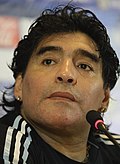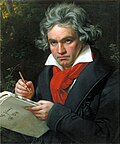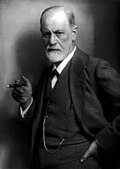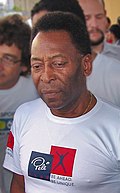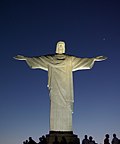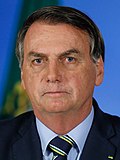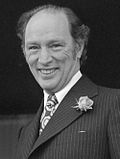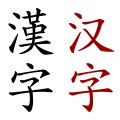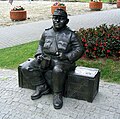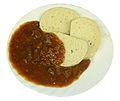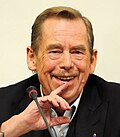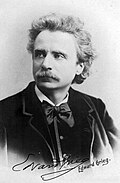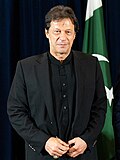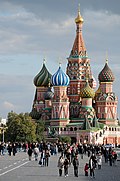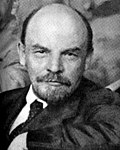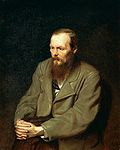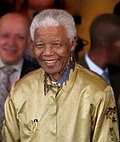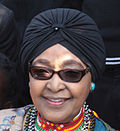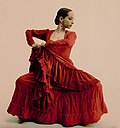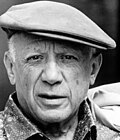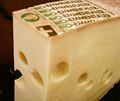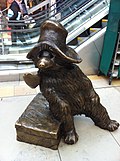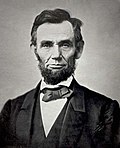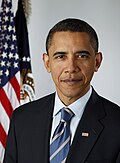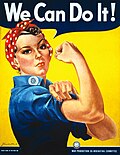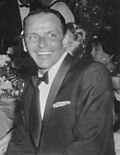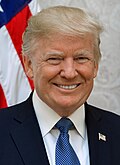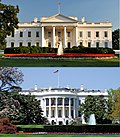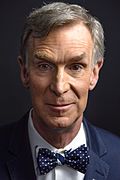Cultural icon
A cultural icon can be a symbol, logo, picture, name, face, person, building, or other image. It is easily recognized and generally represents an object or idea with great cultural significance to a wide cultural group. It has a special status as representing, or important to, or loved by, a particular group of people, a place, or a period in history.
In the media, many well-known examples of popular culture have been called "iconic". Some writers say that the word is overused.[1][2][3]
Icons and persons
According to Times of India:
Che Guevara, Madonna, Jim Morrison, James Dean, Marilyn Monroe, John Lennon, Michael Jackson, Frank Sinatra, Bob Marley, Elvis Presley, Kurt Cobain, the Beatles, Elizabeth Taylor, Walt Disney — these are names that refuse to fade out. No generation gap can lower their popularity. They will always remain a symbol of youth.
—
Icons and brands
Brands can show social values and changes, but many people have become tired of them.[5] Many brands want to be cultural icons, but fail. Cultural icons are often timeless, imprinted in our consciousness. They can go through several stages, from "rumblings, undercurrents" via "catharsis, explosion" and "mass acceptance, ripple effect" to "glorification, representative value". While brands are rational and driven by features, cultural icons are emotional, free, driven by feeling, and creating emotional bonds. An example of "branding" might include the wearing of a consistent fashion look by such music stars as Michael Jackson or Elvis Presley, making them instantly recognizable. Royal or church clothing could also be understood as a form of emotional iconography.
Examples include: Andy Warhol, Budweiser, BMW, Chanel, Coca-Cola, Guinness, Harley-Davidson, LEGO, Martha Stewart, Nike, Norman Rockwell, Vuitton, Škoda Auto...
Definition
Cultural icons may be national, regional or about a city. And they can be symbols for a nation, or can show the values held by that state. For example, France uses Marianne as a symbol of the French Revolution. Bruce Lee is a symbol for the martial arts and philosophical culture of insight and knowledge in the entire world.[6][7][8] Charlie Chaplin symbolises comical action while Clint Eastwood is a symbol for strength and masculinity. Jackie Chan is a global icon of comical stunts and martial arts based action.[9] Salvador Dalí is the worldwide icon for the bizarre and eccentric.
Media overuse
Some writers say that the terms "icon" and "iconic" have been overused. A writer in Liverpool Daily Post calls "iconic" "a word that makes my flesh creep", a word "pressed into service to describe almost anything".[1] The Christian Examiner added "iconic" and "amazing" to its list of overused words. It found over 18,000 "iconic" references in news stories alone, with another 30,000 for "icon", including use of it for SpongeBob SquarePants.[2]
Icons by selected Countries
Argentina
Australia
Austria
Brazil
Canada
China
- Mao Zedong 1963 (cropped).jpg
Czech Republic
Denmark
Ecuador
France
Germany
Hungary
India
Ireland
Italy
Jamaica
Japan
Macedonia
Mexico
Netherlands
Norway
- Leif Ericson on the shore of Vinland.gif
Pakistan
Russia
South Africa
Spain
Sweden
Switzerland
United Kingdom
Cucumber sandwiches with Tea
United States
Bald eagle (national bird)
- Superman is ready.jpg
The Apollo 11 Crew: Neil Armstrong, Buzz Aldrin, and Michael Collins
- Rosaparks.jpg
Related pages
References
- ↑ 1.0 1.1 Let's hear it for the Queen's English Archived 2014-06-11 at the Wayback Machine, Liverpool Daily Post
- ↑ 2.0 2.1 Modern word usage amazingly leaves us yearning for gay, old times Archived 2013-02-26 at the Wayback Machine, Christian Examiner
- ↑ Heard about the famous icon? We have - far too often Archived 2012-10-26 at the Wayback Machine, The Independent (London), January 27, 2007
- ↑ The Past Beckons
- ↑ "Lessons from Cultural Icons - How to Create an Iconic Brand" (PDF). Archived from the original (PDF) on 2012-09-15. Retrieved 2013-02-14.
- ↑ Stein, Joel (14 June 1999). "Bruce Lee: With nothing but his hands, feet and a lot of attitude, he turned the little guy into a tough guy". The Time 100. New York: Time Inc. Archived from the original on 5 June 2010. Retrieved 7 June 2010.
- ↑ "From Icon to Lifestyle, the Marketing of Bruce Lee". nytimes.com. 11 December 2009. Retrieved 3 June 2011.
- ↑ "Dragon's Heart: A kungfu master's living legacy". chinadaily.com. 5 January 2011. Retrieved 10 June 2011.
- ↑ "Stuntman to Martial Arts Superstar Jackie Chan reveals the man behind the camera on CNN's Talk Asia". CNN-Asia Pacific. 9 April 2008. Archived from the original on 2 October 2011. Retrieved 10 June 2011.




